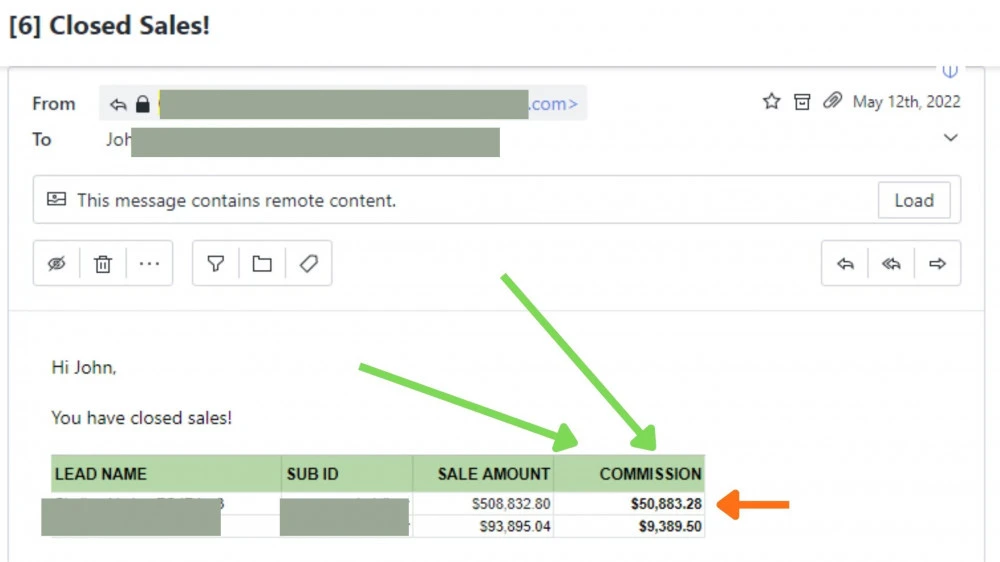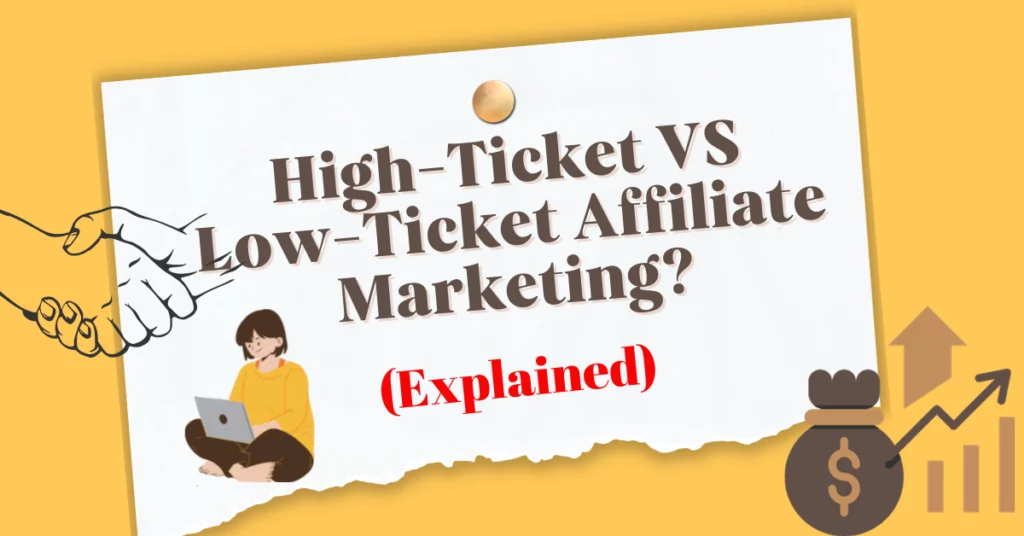High Ticket vs Low Ticket Affiliate Marketing… That what you are searching right?
You are not able to understand the nuance around High Ticket vs. low Ticket Affiliate Marketing and what is the better choice for you.
No problem!
The Wealthy Affiliate Academy comparison helps you make the best decision
I have utilised both strategies to help me increase my affiliate earnings even though low-ticket affiliate marketing requires a higher number of sales to make a decent commission.
This small guide will cover:
- Understanding High Ticket Affiliate Marketing
- Delving into Low Ticket Affiliate Marketing
- Comparative Analysis: Profit Margins, Sales Volume, and Marketing Strategies
- Who Should Opt for High Ticket, Who Should Go for Low Ticket
Without further ado let’s get started…
In the bustling digital market, affiliate marketing stands out as a strategic way for companies to expand their reach and individuals to create profitable earnings streams.
It is a deal where you promote someone else’s products or services, and in return, you get a commission for every sale made through your referral.
Neat, right?
But within this arena, there’s a fork in the road: high ticket vs low ticket affiliate marketing.
High-ticket items are those that come with a hefty price tag and, consequently, larger commissions.
On the flip side, low-ticket items are more affordable but offer smaller commissions per sale.
You are probably wondering which road to take.
Well, that is going to include understanding the nuances of both options.
This article is not just about plastering information; it is also about offering you the clarity to make an informed choice.
Whether you’re just dipping your toes into affiliate marketing or looking to shift your existing strategy.
I’m here to help you navigate these waters.
Understanding High Ticket Affiliate Marketing
When you hear ‘high ticket,’ think of products or services that command a higher price point – and consequently, offer heftier commissions.
Single sales can yield substantial payouts, hence attracting affiliates who are after larger earnings per conversion.
However, it is not just about the bigger paydays.
High-ticket affiliate marketing involves more complex sales processes, typically requiring a deeper understanding of the product and a trustworthy relationship with the audience.
The sales cycle can be longer, but the rewards can be quite gratifying.
You are going to find out about the pros of high-ticket affiliate marketing.
These include substantial commissions, the potential to work with prestigious brands, and the need for fewer sales to meet income goals.
And of course, there is the allure of positioning oneself as a purveyor of premium products.
But let’s be real, it also comes with it is challenges.
A more significant investment of time and often money into marketing efforts, the necessity for a strategic approach to persuade discerning customers, and a smaller target audience due to the higher price barrier are critical concerns to navigate.
Typically, high ticket offers are found in industries like business-to-business (B2B) services, luxury goods, high-end electronics, and comprehensive courses or consulting services.
They are products with not just a high price tag but also a high-value perception.
If you’re intrigued by the high-ticket route, stay tuned.
or you can sign up 15 Day Online Business Builder Challenge and start an online business that earns high-ticket commissions
Next, we are going to explore low-ticket affiliate marketing and it is important to understand both ends of the spectrum to make an informed decision on which path suits you best.
Delving into Low Ticket Affiliate Marketing
You might be wondering what sets low-ticket affiliate marketing apart.
In essence, low-ticket items are ones with a lower price point, often leading to more impulse buys and a faster decision-making process for the customer.
Unlike high-ticket products, these are items that won’t make a significant dent in the buyer’s wallet.
So why would you choose to focus on selling items that generate less profit per sale?
The key advantage here lies in volume.
With low-ticket items, you are looking to close a higher number of sales.
The accessibility of the price often means a larger audience, which can lead to more commissions stacking up over time.
But it is not all smooth sailing.
One potential drawback you will want to consider is the sheer effort involved.
To achieve substantial revenue, you have to push volumes, which can mean more marketing campaigns, content production, and audience engagement.
Typical products and services offered as low-ticket items include eBooks, budget software subscriptions, or cheaper gadgets and accessories.
These are often products that customers can easily understand and make quick decisions about, reducing the need for extensive guidance or long deliberation periods.
Despite the lower per-sale profit, the cumulative effect of many sales can be significant.
Smart marketers leverage the opportunity for repeat purchases, building a long-term relationship with each customer that goes beyond a one-time transaction.
Comparative Analysis: Profit Margins, Sales Volume, and Marketing Strategies
Now, let’s tackle the crucial elements: profit margins, sales volume, and marketing strategies.
What you are going to find out about here is how to balance between earning big with fewer sales and earning smaller amounts numerous times.
With high-ticket affiliate marketing, profit margins often soar.
Selling one high-ticket item can be equal to or more of the revenue from selling multiple low-ticket products.
This means you do not need a vast audience, just a select group interested in premium offers.
As you can see here one of my friends sold a product that cost over $500k and earned a commission of almost $50k per sale

You can read his blog post “Affiliate Marketing Motivation $60,000+ in 1 Day!” so that I’m not making things up.
However, the catch is the sales frequency, which tends to be lower due to the high price point.
Conversely, low ticket affiliate marketing plays by the volume game.
The profit per sale might be meagre compared to high-ticket items, but the magic happens when you scale up.
With a larger potential customer base, due to smaller prices, the sales volume can skyrocket.
This strategy requires constant engagement and a robust marketing push to maintain high sales volume.
The marketing strategies for each are distinctive.
High-ticket items often necessitate a personalized approach.
We are talking about tailored email campaigns, one-on-one interactions, or exclusive webinars.
Your potential customers need to feel the value and trust of the high investment they are considering.
Low ticket items, however, benefit from broader reach marketing tactics.
Think social media blasts, SEO-focused content to pull large traffic, and email marketing with a more frequent, sales-focused cadence.
Both approaches require a keen understanding of your audience and a strategy that aligns with their interests and purchasing behaviours.
High ticket sales rely heavily on trust and relationship-building, while low ticket tend to focus on efficiency and accessibility.
And there you have it – the contrast between focusing on large, infrequent paychecks versus smaller ones that come more regularly.
Moving forward, you will need to ask yourself what suits your style, preferences, and resources best.
Will it be the high stakes of high ticket sales or the rapid turnover of low ticket items?
Therefore, if you want to test the water of this business model Wealthy Affiliate can teach step by step on how to build niche affiliate website and start earinging affiliate commission.
Who Should Opt for High Ticket, Who Should Go for Low Ticket
I’m here to help you figure out which type of affiliate marketing aligns with your goals, skills, and resources.
It is not a one-size-fits-all situation.
In my opinion, the choice between high-ticket and low-ticket affiliate marketing rests on understanding your strengths and the preferences of your audience.
Choose high-ticket affiliate marketing if you have a knack for building trust and relationships.
It is ideal for those who have an audience interested in premium products and do not mind a slower, more strategic sales process.
If you are someone who values quality over quantity and has the patience to nurture leads, the high ticket could be your gold mine.
On the flip side, low-ticket affiliate marketing is your playing field if you are adept at driving volume sales.
This suits you if you can persuade a broad market, favour a faster sales cycle, and like to see quicker returns, albeit smaller per sale.
It also requires less of an upfront investment, making it a more accessible entry point for newcomers.
Your choice should also factor in your audience demographics.
If your followers are budget-conscious shoppers, pushing high-ticket items might not resonate with them.
Likewise, if they are after luxury or specialized products, low ticket offerings may leave them unsatisfied.
In essence, your decision should stem from a blend of your marketing strengths and your audience’s inclinations.
You can always adjust your approach down the road, but starting aligned with your and your audience’s core preferences will save you time and effort.
High-Ticket vs Low-Ticket Affiliate Marketing -Conclusion and Future Insights
You have just explored the dynamic world of high-ticket versus low-ticket affiliate marketing.
From the in-depth comparison, you can now appreciate that both paths offer unique opportunities and challenges.
Choosing one is not just about preference; it’s about aligning with your goals, resources, and audience.
If you are leaning toward high ticket marketing, remember it’s a marathon, not a sprint.
Building trust and a solid reputation takes time but can result in significant rewards.
On the flip side, low-ticket marketing may offer quicker wins and a faster-paced environment, but it requires a volume-driven strategy.
Embrace the approach that resonates with you and your audience.
It is vital to understand your market and deliver value that meets their needs and expectations.
Your first attempt does not need to be your last.
You can always adjust your approach down the road.
Looking ahead, the affiliate marketing industry is evolving rapidly.
Changes in consumer behaviour, advances in technology, and market competition all play a role in shaping future strategies.
Keep learning, be adaptable, and stay on top of trends to ensure your affiliate marketing approach remains effective.
Whether you decide to promote high-ticket items, low-ticket items, or a mix of both, focus on maintaining authenticity and providing genuine value.
That is the strategy I like to leverage, and I hope that you achieve remarkable success in your affiliate endeavours.
If you are new to affiliate marketing and you want to learn check out My Top Recommentation Platform for step by step training.
The alternative to this training is the Legendary Marketer
Now I would like to turn things over to you: Did I miss anything that I did not cover in this small guide?
Do you think about High Ticket Vs Low Ticket Affiliate Marketing?
Or maybe you have other tricks I did not cover here that help you make more money.
Either way, let me know and leave a comment below
